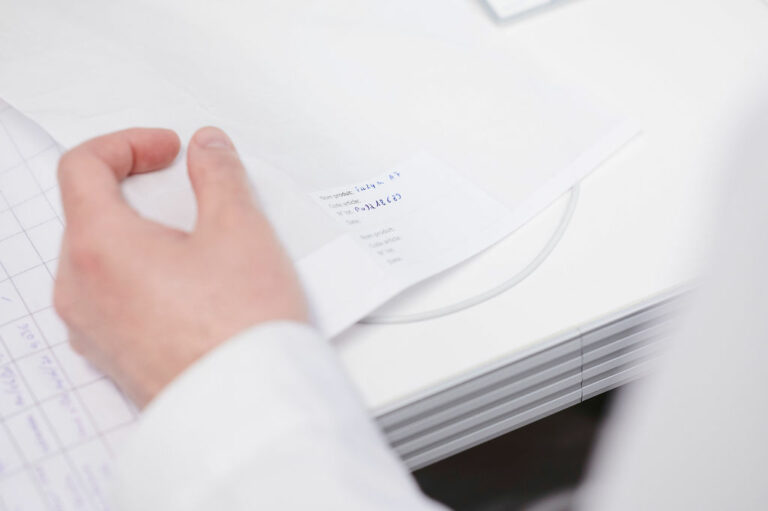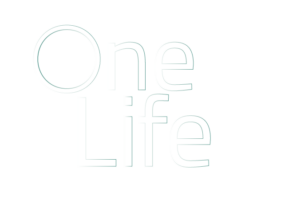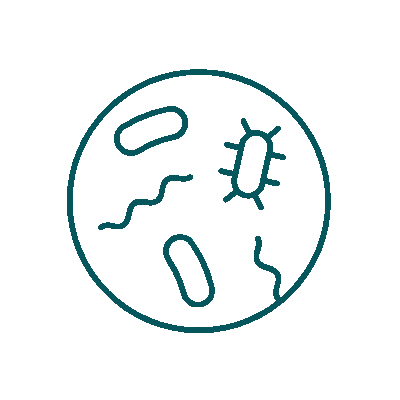Frequently Asked Questions
Q&A

All our enzymatic detergents should be kept between 4-25°C. We do our accelerated stability testings at 35°C for all products. Products like enziMed Prevent and enziQure and enziMed Instrument Washer resist very well at these temperatures for more than 10 weeks. enziMed Standard and enziMed Pre-cleaner are more sensitive but exposure to 35°C for up to 13 days was found to cause no degradation of the products.
40 – 45°C has been determined as the ideal temperature for optimal enzymatic activity. In fact, tests on 10 Medical Device detergents (enzymatic and non-enzymatic) confirm that most products perform significantly better at 40°C than at 25°C. The reasons for that are the following :
40 – 45°C is thus a trade-off.
In any case, enzymes should not be used in excess of 55°C as some of them (proteases) will be denatured and lose their activity. Denaturation is irreversible.
OneLife detergents are not classified as biocides because biocides are classified based on product claims and OneLife products have no antimicrobial activity and do not kill microorganisms (which also has the advantage of do not create resistances as is the case for quaternary ammonium).
There is no general rule as cleaning efficacy depends on many parameters in the decontamination process (time between instrument use and cleaning, detergent used, respect of detergent protocol, use of ultra-sound bath, level of training of the personnel etc.).
In general, in CSSDs, contamination rates vary from 0% to 60%. In dental offices, these rates may increase to 100% of instruments that are contaminated.
OneLife’s technology has been validated by external laboratories :
- WFK Testing Institute in Germany for protein detection
- Biotech-Germande Laboratories in France for biofilm matrix detection3 posters have been presented using OneLife DETECT at the French Society for Sterilization Sciences conference in September 2017.
- The performance of OneLife’s detergents has been validated by several external laboratories (including Louvain Drug Research Institute, Catholic University of Louvain, Belgium) for their performance against protein soil and biofilm matrix.
- The latest test results have been published or presented.WFHSS – World Federation for Hospital Sterilisation Sciences :
o 05/10/2017 – 10.45-12.15 : Presentation Dr.Thomas Vanzieleghem – Subject: “ Removing biofilms from endoscopes: the importance of the cleaning chemistry »
o October 2017 (05/2017) : ZentralSterilisation/Central Service, Siala et al. (UCL) « Biofilm removal properties of endoscope cleaners : a comparative study”
o June 2017 : Infection control and Hospital Epidemiology (ICHE ), Cattoir et al. (UZ Gent) “Surveillance of Endoscopes: Comparison of Different Sampling Techniques”
o March 2019 (7(4)) : Endoscopy International Open, Alfageme Gonzalez and Vanzieleghem et al. (CHU de Liège) « On-site comparison of an enzymatic detergent and a non-enzymatic detergent-disinfectant for routine manual cleaning of flexible endoscopes.”
o September 2018 : SF2S Congress, Lambert (CH Chambery) “ Contamination des implants d’ostéosynthèse au bloc opératoire : mythe ou réalité ? » à Field study using DETECT Kit
The 2-in-1 products that claim cleaning and disinfection efficacy are in general poor cleaning agents. The main reason is that the disinfectants used in these products are detrimental to the cleaning process. Indeed, quaternary ammonia (positively charged) are fixating proteins (most abundant soils on medical device – negatively charged) causing their irreversible adhesion to the surface of medical devices. Oftentimes, it results in instruments that are still visibly dirty. This would endanger the sterilization or disinfection process because residual soils and biofilms interfere with sterilization/disinfection.
In addition to being poor cleaning agents, the 2-in-1 products are generally weak disinfectants also. Their potency against bacteria, viruses and fungi is far from that of disinfectants alone (such as peracetic acid or hydrogen peroxide) which have better killing rates (faster killing curve and more complete inactivation of microorganisms).
In short, our approach is to provide enzymatic products that are excellent cleaners to render 100 % clean instruments after the wash phase and prepare the instruments for optimal sterilization or disinfection.
Our products are meant to be used in the first phase of reprocessing (pre-cleaning and cleaning) in order to physically lift off soils and microbes from the surface of the instruments. Our product do not kill viruses and bacteria, they simply put the microbes and soils into suspension so they are not attached to the instruments any more and can be rinsed off easily.
Thorough (pre-)cleaning using OneLife products ensures that medical devices are fully clean before chemical disinfection or sterilization can be achieved. This is essential as instruments that are not 100% clean cannot be sterilized or disinfected effectively (source : CDC).
Our products do not have disinfectants inside and will therefore have no inactivation claim against viruses, bacteria, fungi, yeast or Giardia. These will be killed in the disinfection or sterilization phase for sure.
In biofilms, the polymers of the matrix are often complex and diverse. OneLife has selected the enzymes that target important and structural component of the biofilm matrix in order to dissolve it effectively.
OneLife has also selected carefully the most potent proteases on the market to break down proteins from blood, mucus and tissues that remain on medical devices such as instruments and endoscopes after use. These proteases must be effective against soluble but also insoluble proteins like fibrin.
How the enzymes are formulated will also have a strong influence on the efficacy (enzymatic activity and stability).
OneLife’s ability to formulate enzymes is built on the 25 years’ experience of our parent company, Realco.
The approach of traditional chemicals manufacturers is often to simply add some enzymes to their chemical formula. This approach can lead to enzyme destabilization and loss of enzymatic activity in the product.
OneLife’s approach is to start with the enzymes and to add the appropriate surfactants that we know are complementary to the enzymes and appropriate for the particular application. In this way, there is a synergy between enzymes and surfactants. Surfactants help the enzymes penetrate the soil and biofilms and the enzymes solubilize soil and biofilm by degrading the polymers into small, soluble compounds. The result is a complete degradation of soil and a physical release and elimination of the microorganisms trapped in biofilms, exposing them to disinfectants.
The only real way to demonstrate efficacy is through performance testing. For the reasons described above, the arguments regarding the number of enzymes are not necessarily an indication as to the quality of the detergent.
To summarise, the most important comparison points for enzymatic detergents are the following:
- The types of enzymes used that will determine which types of organic matter are broken down. OneLife’s high-level detergents break down protein-based soil as well as the matrix of different bacterial biofilm (formed by different species).
In our published tests of 11 different Medical Device detergents, we are the only detergent (enzymatic and non-enzymatic) to break down biofilm of all 5 different species tested. In order to achieve this, our detergents contains different types of protease and polysaccharidases, as well as lipase and laccase. Within each enzyme “family”, such as protease and polysaccharidase, there are different types available that need to be selected carefully by the manufacturer in order to target the desired polymers. OneLife’s multi-enzymatic formula with biofilm treatment is protected by a patent.
- The quantity of enzymes, or the concentration, will also naturally impact the detergent efficacy. OneLife’s detergents contain very high levels of enzymes; particularly enziQure. The concentration of enzymatic activity in our detergent is up to 50 times higher compared to other enzymatic detergents on the market. Enzyme concentration in a detergent is not a piece of information that can be found on a technical data sheet or a safety data sheet making it complicated to compare detergents.
Our enziMed Products are cleaning agents (detergents) based on enzymatic technology.
Enzymes are natural catalysts that break down organic matter such as soil, blood, tissue… into soluble molecules without being consumed in the reaction.
Being a catalyst also means that enzymes speed up specific biochemical reactions and in this case, they improve the cleaning efficacy drastically.
Our main focus and expertise lies in our capacity to assemble enzymatic cocktails that are effective to remove soils but also microbial biofilm which can colonize medical instruments (surgical instruments and endoscopes).


